To avoid causing harm to active bird nests, it’s important to understand how your hedge-trimming plans impact the local ecology. There are specific times of year that are better for hedge pruning and cutting than others, when considering the best ways to avoid nesting birds. So, let’s assess when to cut hedges to avoid nesting birds.
You should only cut hedges outside of bird nesting months; these are typically from March–August, but can vary depending on weather conditions. It is a legal offence to harm nesting birds or their eggs.
Keep reading to learn more about how to identify nesting birds in your hedges and what to do if you find a nest.
About Bird Nesting Seasons
Hedges provide shelter from predators and the elements, offering birds a vital safe nesting space. Therefore, it’s important to be extra careful when trimming hedges, as you might not be aware of the birds hidden away between the branches.
If you need more information about when to prune trees, check out our blog: When To Cut Back Trees — Your Guide To Pruning
Nesting Seasons and When to Avoid Hedge Work
Birds go through nesting seasons (breeding periods that require a safe place to keep eggs and raise hatchlings), typically from March–August. During these months, a nest will almost never be abandoned.
Before considering any work, you should check that any nests you find are completely abandoned and have been for some time. This will ensure that you are not disturbing, destroying, or removing a crucial habitat for nesting birds and growing hatchlings, which would be a legal offence in the UK.
The Law
Most wild birds in the UK are protected by law in a number of ways that you need to be careful of when planning to work on hedges and trees during nesting seasons. It is against the law to carry out any of the following actions:
- intentionally kill, injure, or take wild birds,
- intentionally take, damage, or destroy a wild bird’s nest while it’s being used or built,
- intentionally take or destroy a wild bird’s egg,
- possess, control, or transport live or dead wild birds, or parts of them, or their eggs,
- sell wild birds or put them on display for sale,
- use prohibited methods to kill or take wild birds.
Some birds, such as barn owls, are protected by the law to a greater extent. These are known as Schedule 1 Birds. For these species, it is also an offence to intentionally do the following:
- disturb them while they’re nesting, building a nest, in, or near a nest that contains their young,
- disturb their dependent young.
If you are found guilty of any of the listed actions above, you could receive an unlimited fine and up to 6 months in prison for each offence.
How To Identify Bird Nests In Trees and Hedges
Identifying a bird’s nest in a tree, especially when it’s located high up in the crown, can be tricky. However, it’s important to be able to correctly identify nests against a backdrop of dense foliage.
To help you identify nesting birds at your home, there are 3 key things you can do:
- Watch for movement
- Determine if the nest is active
- Look for interactions between nestlings and adult birds
Before doing anything, though, identify where and how you want to trim your hedge so that you understand properly which areas will be impacted by the work.
Watch for Movement
Look around inside the hedge for dense patches where new limbs have formed on the branches; this is where birds prefer to build nests. Bird nests are built up of flora from other trees, shrubs or plants, and they should stand out as denser areas between the branches.
To help, position yourself behind the hedge so that the sun shines through it to illuminate everything inside. You can also look out for birds flying in and out of the shrubbery.
Determine If The Nest Is Active
Before attempting to remove a nest, it’s important to see if birds are currently living in it. To do so, you can use binoculars and monitor the nest for a few days. Look for any signs of activity, and note whether any baby birds are present. It’s best to avoid approaching the nest until you are sure it is safe to do so.
Look For Interactions Between Nestlings And Adult Birds
Nestlings and fledglings will cheep to their parents regularly. These interactions are unmistakable and can usually be heard within a reasonable distance.
Adult birds will also return to nests many times in one day. If an adult can be seen moving twigs, straw, and grass up into a canopy or into a hedge, it is likely building a nest. You may also be able to see the adults removing the faecal sacs from the nest, or returning with worms and other small insects.
What Should You Do If You Find Bird Nests In Your Garden?
If you have managed to locate a bird’s nest on your property, you must not under any circumstances disturb or try to remove it.
The Wildlife and Countryside Act 1981 stipulates that you are guilty of an offence if you, or anyone under your supervision, intentionally take, damage, or destroy a wild bird’s nest while it’s being used or built.
You can read more about the protective laws around wild bird nests above.
For any criminal offence related to a single bird, nest or egg, you can receive unlimited fines, up to six months imprisonment, or a combination of both penalties. However, this law is only applicable to brooding or nesting birds. If you have found there to be no birds currently using the nest, you are free to do with this nest as you wish.
Getting Professional Help With Nesting Birds in Your Trees
If you have nesting birds in your trees, the RSPCA or RSPB won’t come out and move them for you. Licences are available allowing work on bird nests that are populated; however, this is safeguarded for extra special occasions where the bird would be better off elsewhere due to a building project or other unavoidable plan.
Getting the advice of a professional tree surgeon, therefore, is the best bet to help you assess the situation before any offences are committed. Tree surgeons can give you advice on how and when it is best to trim hedges, thin crowns, or remove trees altogether.
If you are located in Kent or South London, don’t hesitate to contact Broadleaf Tree Surgery to help with any trees on your property today.
When To Cut Hedges To Avoid Nesting Birds FAQs
Laurel hedges — trim in late spring or early summer
Evergreen hedges — avoid heavy trimming during extreme cold or heat during summer or winter
Deciduous hedges — trim in late winter or early spring before they have heavy growth
Quickthorn/Hawthorn hedges — trim in late autumn or early spring
Blackthorn hedges — trim in late summer or early spring, before new nesting seasons begin
You can get more advice from a professional tree surgeon by getting in contact with Broadleaf Tree Surgery.
- Use a quieter electric tool or manual tools
- Cut slowly and avoid shaking branches or cutting deep into dense parts where nests may be
- Leave some hedge structures — such as growing berry branches — intact
- Hedge Trimming
- Emergency Tree Surgery
- Tree Felling & Removal Services
- Deadwood Removal
- Commercial Tree Work
- Aerial Tree Inspections



